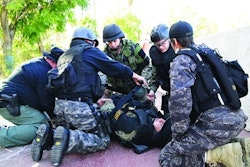As Autumn arrives, rains have begun falling, leading to flash flooding that has—in one recent incident, at least—prompted law enforcement officers to race to the rescue of citizens swept away in the rapidly rising waters.
According to CBS News, Officers with the San Bernardino (CA) Police Department recently rescued a woman and her two children who at one moment were standing in ankle-deep water and in the very next moment were being washed away by the force of the shallow but swift water.
Officers Jonathan Mason, Gabriel Rodriguez, and Tommy Tran—all rookies with less than a year on the job—leaped into action, pulling all three victims to safety.
Tran later told NBC News, "Never once in the academy did we train for a swift water rescue."
That's a problem—an untrained person attempting a rescue in swift water could easily turn into another person in need of rescue.
Swift-Water Basics
Without getting in too deeply into things like the Reynolds Number—and other artifacts of the high school physics classes most of us have long since forgotten—suffice to say that moving water is inherently dangerous. Moving water has unseen—or at least hidden to the untrained eye—factors and forces that must be accounted for.
Regardless of whether you're dealing with a flooded stream or a flooded street, there are two types of flow—laminar and turbulent.
Turbulent flow is indicated when the surface shows eddies and swirls—and at times whitewater—caused when uneven surfaces beneath or other submerged elements cause the layers of flow to be interrupted and intermingled. Laminar flow shows little to no surface disturbance because the fluid layers continue together in a mostly parallel path. Laminar water is often misconstrued to be "calm" but it can easily knock a person off their feet.
Understand going in (no pun intended) that the water is stronger than you. The force of a moving body of water is a function of its velocity and its volume. The volume of water in an urban setting can be discernable by reckoning the surface level with familiar objects. Midway up a typical fire hydrant is about a foot of water, for example. The velocity of water is often difficult to gauge by sight, but let's assume that it's about the same as a walking pace—four miles per hour or so.
That one-foot-deep flow of water at four miles per hour will exert a force of about 60 pounds per square foot of submerged surface area—for a typical person, two legs in a foot of water exposes about one square foot of surface area.
One might think this to be manageable—until you add in the complications of submerged hazards, slippery surfaces, and a potentially panicked victim in your clutches.
Up the water's velocity to eight miles per hour, and you're looking at well over 200 pounds of force per square foot, and now you're essentially looking at being tackled by an NFL linebacker. Add in the fact that the water temperature is almost certainly going to be uncomfortably—or dangerously—cold, and things can get unmanageable in a hurry.
Training is Essential
There are some simple ways to increase the survivability of an attempted water rescue. First and foremost is to be in good physical condition—an officer who is not in tip-top shape is already at a serious disadvantage against moving water. Secondly, get rid of your gear—your duty belt is of no use when you're in the drink, so leave it on land. Thirdly, try to use features of the current—particularly eddies and swirls that are adjacent to obstructions in which the downstream current is negated or even reversed—as areas of safety. Finally, work in teams whenever possible.
The officers in San Bernardino earlier this month were brave and heroic and magnificent. They were also a little lucky because they overcame adverse circumstanced despite never having been trained to do it.
This event—and countless others like it—should serve as a clarion call for agencies to provide swift-water rescue to officers. A great venue to find that training might be as nearby as your local partners in the fire service.
Mother Nature can be a cruel creature—she can be an unpredictable, unrelenting, unforgiving, and unrepentant agent of death and destruction. Officers must prepare for the inevitable eventuality of being called to assist citizens who are impacted by her sudden fury, and training is essential for survival in such circumstances.
















